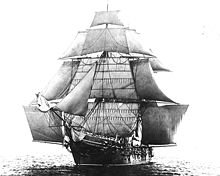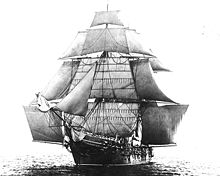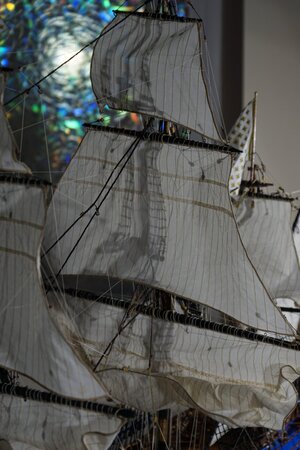-

Win a Free Custom Engraved Brass Coin!!!
As a way to introduce our brass coins to the community, we will raffle off a free coin during the month of August. Follow link ABOVE for instructions for entering.
-

PRE-ORDER SHIPS IN SCALE TODAY!
The beloved Ships in Scale Magazine is back and charting a new course for 2026!
Discover new skills, new techniques, and new inspirations in every issue.
NOTE THAT OUR FIRST ISSUE WILL BE JAN/FEB 2026
You are using an out of date browser. It may not display this or other websites correctly.
You should upgrade or use an alternative browser.
You should upgrade or use an alternative browser.
are you looking for the fine threads showing the direction of wind directly on the sail,
or the reefing lines to reef the sails?
or the reefing lines to reef the sails?
The term is correct - I made until now only the reefing lines, which are bigger in diameter.I mean the fine theats showing the wind direction placed directly on the sail. Do they not called telltales or telltails?
In which scale you have to make them?
- Joined
- Dec 24, 2019
- Messages
- 197
- Points
- 113

If you Google: ‘Davis Instruments tell tales’ you’ll see commercially available packs of 1/4 inch wide nylon spinnaker cloth strips about 6 inches long with self adhesive patches to stick them to sails. They work just fine and don’t stick to wet sails, so you can see air flow over the sail
Modern day racing sailors do use tell tell tails on their sails — but I’m not aware that professional working mariners ever needed them. Anyone ever hear of them being used on traditional
Modern day racing sailors do use tell tell tails on their sails — but I’m not aware that professional working mariners ever needed them. Anyone ever hear of them being used on traditional rigs?

Here you can see them.
Those are reef points. (what a tiny photo!)
These lines hang down on both sides of the sail, and their purpose it to give sailors something easier hold onto that just sail cloth when hauling the sail up to the yard when furling the sail. They are not there for the purpose of showing the air flow across the sail to allow modern sailboat sailors to perfectly trim their sails for efficiency using the airfoil effect to generate force, which are telltales. Propeller driven aircraft have been using tell tails for many decades to detect when they are approaching a stall condition. The flutter of a wing's telltale shows turbulent airflow, and signals that to the pilot. It is possible that reefing lines could act as a wind flow indicator to a small extent, but that it not their intended purpose. Reefing lines are there to make the sailor's job of reefing in large sails easier. I am unaware that large square rigged ships ever used talltales, but it is possible. Pennants or streamers would tell the sailors the direction of the wind quite well. Modern sailboats rigged with fore-aft sailors such as the common Bermuda sloop us telltales to get the most apparent wind (force due to the airfoil effect) as possible with their sails. The sails on these boats today are much flatter than those of old square rigged vessels. Early 17th century men of war had deeply bellied sales compared to later ship of the 18th century, and thus trimming a sail using telltales would probably have not been in practice.

These lines hang down on both sides of the sail, and their purpose it to give sailors something easier hold onto that just sail cloth when hauling the sail up to the yard when furling the sail. They are not there for the purpose of showing the air flow across the sail to allow modern sailboat sailors to perfectly trim their sails for efficiency using the airfoil effect to generate force, which are telltales. Propeller driven aircraft have been using tell tails for many decades to detect when they are approaching a stall condition. The flutter of a wing's telltale shows turbulent airflow, and signals that to the pilot. It is possible that reefing lines could act as a wind flow indicator to a small extent, but that it not their intended purpose. Reefing lines are there to make the sailor's job of reefing in large sails easier. I am unaware that large square rigged ships ever used talltales, but it is possible. Pennants or streamers would tell the sailors the direction of the wind quite well. Modern sailboats rigged with fore-aft sailors such as the common Bermuda sloop us telltales to get the most apparent wind (force due to the airfoil effect) as possible with their sails. The sails on these boats today are much flatter than those of old square rigged vessels. Early 17th century men of war had deeply bellied sales compared to later ship of the 18th century, and thus trimming a sail using telltales would probably have not been in practice.
Last edited:
- Joined
- Dec 24, 2019
- Messages
- 197
- Points
- 113

Darius is correct, you’re looking at reef points, not tell tales.View attachment 325718
Here you can see them.
Ok, thanks for your detailed answer.Those are reef points. (what a tiny photo!)View attachment 325723
These lines hang down on both sides of the sail, and their purpose it to give sailors something easier hold onto that just sail cloth when hauling the sail up to the yard when furling the sail. They are not there for the purpose of showing the air flow across the sail to allow modern sailboat sailors to perfectly trim their sails for efficiency using the airfoil effect to generate force, which are telltales. Propeller driven aircraft have been using tell tails for many decades to detect when they are approaching a stall condition. The flutter of a wing's telltale shows turbulent airflow, and signals that to the pilot. It is possible that reefing lines could act as a wind flow indicator to a small extent, but that it not their intended purpose. Reefing lines are there to make the sailor's job of reefing in large sails easier. I am unaware that large square rigged ships ever used talltales, but it is possible. Pennants or streamers would tell the sailors the direction of the wind quite well. Modern sailboats rigged with fore-aft sailors such as the common Bermuda sloop us telltales to get the most apparent wind (force due to the airfoil effect) as possible with their sails. The sails on these boats today are much flatter than those of old square rigged vessels. Early 17th century men of war had deeply bellied sales compared to later ship of the 18th century, and thus trimming a sail using telltales would probably have not been in practice.
Now, if you want to attach a reef points on the sail of a model ship, how do you do it in a good way?Darius is correct, you’re looking at reef points, not tell tales.
I've done it two different ways. The first was to sew a reef band horizontally on the sail. Then I sewed the reef points through that band, tied knots up close to the sail on either side, and cut off the excess line. I've tried both one and two reef points per cloth segment. One looks better to me. I've also used white glue to attach bands and points. It's a LOT quicker and looks as good imho.Now, if you want to attach a reef points on the sail of a model ship, how do you do it in a good way?

- Joined
- Feb 20, 2022
- Messages
- 225
- Points
- 113

This is one of the more tedious jobs of making sails look realistic, but it is sure worth it! Imagine being a sailor standing on a footrope, 40 feet in the air, on a rolling ship in a storm, & trying to reef a sail without something on the canvas to grab on to! NOT a fun job, I'm sure! Rick
Some example of making reef lines are shown here (fast search in the forum)
or here
Brigantine Phoenix, by Master Korabel [COMPLETED BUILD]
Great tutorial, Moreplovac, many thanks! The way you making sails remind me of the method of many Russian ship modeling colleagues. Yes, you are correct, borrowing the knowledge and adding my own spices... :)
shipsofscale.com
or here
Marking Sails for Seam Sewing
When I finished marking off the canvas panels on the fabric for my Bluenose sails, a seamstress gave me the recommendation to next time not use a graphite pencil in drawing the sewing lines as the graphite may be hard to remove later. She recommended and demonstrated using this FriXion marking...
shipsofscale.com
Thanks!Some example of making reef lines are shown here (fast search in the forum)
Brigantine Phoenix, by Master Korabel [COMPLETED BUILD]
Great tutorial, Moreplovac, many thanks! The way you making sails remind me of the method of many Russian ship modeling colleagues. Yes, you are correct, borrowing the knowledge and adding my own spices... :)shipsofscale.com
or here
Marking Sails for Seam Sewing
When I finished marking off the canvas panels on the fabric for my Bluenose sails, a seamstress gave me the recommendation to next time not use a graphite pencil in drawing the sewing lines as the graphite may be hard to remove later. She recommended and demonstrated using this FriXion marking...shipsofscale.com


